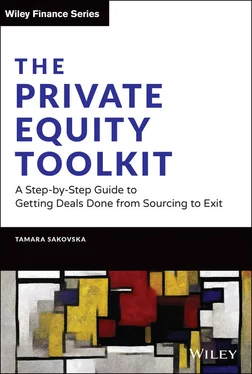DATABASE Roadmap™ 1 for Opportunistic Deal Sourcing
So, how do you go about laying this foundation?
It depends on your starting point and your ambition. You are most likely to stick to the process that works for you in your specific circumstances and feels relatively effortless once it is set up. If you are looking for a general guide, consider the detailed framework below that I developed for an opportunistic deal search. I put this checklist together because I dislike chaos and frequently try to create order out of disarray. Below is my tried and tested recipe for taming the unpredictable force of opportunistic deal sourcing and improving deal search outcomes.
Opportunistic Deal Sourcing: DATABASE Roadmap™
Similar to the Thematic Deal Sourcing ICEBERG Roadmap™, this framework also has an acrostic name to help remember each step better: it is called an Opportunistic Deal Sourcing DATABASE Roadmap™. The steps are as follows:

1 Develop a clear point of view about the kind of deals your fund wants to target.
2 Articulate a concise and memorable message about your mandate.
3 Team up with intermediaries who consistently add value.
4 Add new relevant connections to your network.
5 Build a strong brand.
6 Apply creative thinking to supplement your opportunistic deal flow.
7 Set-up a dedicated tech-enabled platform to manage your deal origination workflows.
8 Establish a business development team fully devoted to deal sourcing.
This is not a prescriptive list. My objective is to provide you with just enough inspiration to create your own framework that incorporates your investment mandate and the inner workings of your firm. Let's start by going through each step in greater depth.
1. Develop a clear point of view about what kind of deals your fund wants to target

Opportunistic deal sourcing features an interesting paradox: in order to find more high-quality deals, you need to focus on fewer segments of the market. Cast your net wide, and you risk sinking in deal entropy of random sectors, business models, endless meetings and follow-ups.
When I started working in private equity, most large firms had a broad mandate that could roughly be described as follows: “We are sector agnostic investors looking to back market-leading companies with recurring revenue streams and sustainable margins led by experienced management teams with a proven track record. We like investing in companies with strong brands and solid customer relationships.” Clearly, this acquisition strategy is too broad and would no longer be successful in today's significantly more competitive market.
It is far more effective to narrow your scope and cherry-pick the kind of deals your fund wants to do. What are some of the specific investment themes you have been developing? Is there a differentiated type of deal that your fund excels in? Do you have a good track record in a particular sector?
Ideally, you will focus on just a few investment niches where your firm has a strong competitive advantage, such as unique knowledge gained through existing investments, deep industry expertise or access to sector experts. If you work in a sector team, you might consider exploring specific subsectors within your industry. Once you have a clear point of view about what kind of deals you are targeting, stick to your investment focus and decline everything else coming your way.
By the way, I can tell you from my experience, this is a hard thing to do in practice. If you are intellectually curious or generally suffer from FOMO (“Fear of Missing Out”), it will take some effort to stay disciplined and not veer off your chosen focus.
2. Articulate a concise and memorable message about your mandate

Once you determine what type of deals you are targeting, your next challenge is to create a well-crafted message to share with a wide audience. You should try to convey two things: first, your specific investment focus, and second, why your firm is the best partner for this type of investment. Here is an example of a more pointed description of what a generalist private equity fund might target: “We are looking to invest $50–100 million in businesses operating in the education, healthcare services or specialty chemicals sectors. Our firm has particular expertise in ‘buy and build’ strategies and taking portfolio companies to international markets.” The mandate described here is brief yet quite distinct: it is limited to three specific industry categories and provides information about target deal size and potential value-add from the private equity fund.
If you are a member of a sector team, there is a good chance that you are covering a very large industry, like business services, technology, financial services or consumer. It might be more helpful to carefully think through and communicate to your network the investment niches within your broad sector that you are working on. For instance, rather than discussing your interest in transactions happening, say, in the consumer sector more generally, specify subsegments of interest, such as holiday parks, organic frozen food producers or manufacturers of ethical skincare products. Finally, aim to include specific and memorable details in your message about your fund's credentials in order to stand out.
3. Team up with intermediaries who consistently add value

Your next objective is to inform your existing network about what types of deals you are looking for and to stay top of mind with the people who might help you source opportunistic transactions.
Your fund has a whole ecosystem of advisers, such as bankers, consultants, industry experts or company executives. Not all of them are always helpful, however. Start by assessing your fund's existing network. Who are the top 10% of intermediaries close to your organization who consistently add value, either by introducing relevant transactions, providing differentiated insights, or keeping you up-to-date with industry developments? You might know the answer off the top of your head. Alternatively, your fund might operate a formal tracking system that allows you to evaluate the strengths and contributions of major service providers on a firmwide basis.
If this is not the case and you are interested in compiling a list of the most effective advisers, you can easily do it yourself by reviewing your pipeline in the last 24–36 months to see who made a material contribution to deal sourcing, industry analysis and transaction execution. Whatever method you choose, the final list should contain a manageable number of parties.
The next logical step is to reach out to all advisers on your list and schedule an update call or a meeting with them in the next few weeks. You can talk them through your current investment focus, provide examples of deals that might interest you and remind them of your fund's credentials in the industry sector that you are pursuing.
Читать дальше
















